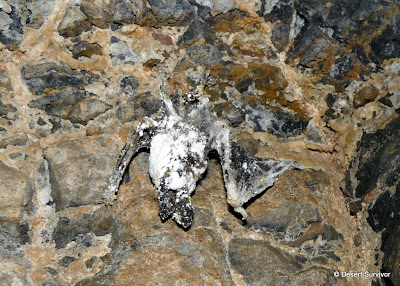This last week I went to the National Cave and Karst Management Symposium in Midway, Utah. It was an excellent symposium, with lots of great information shared, old relationships revitalized, new cave people met, and to top it off, it also included an informative field trip.
We headed up Logan Canyon and after stopping at a couple springs and learning how dye tracing had revealed the water sources to them, we met with a state wildlife biologist and learned about the bats in Logan Cave. This is a fairly large cave with a huge cave opening right by the highway. It has both a maternity and hibernating colony of Townsend's big eared bats, so visits in the summer or winter can impact the bats. About 15 years ago, the gate was put on, and since then the population of bats has increased from about 5 to 250.
Since we were visiting in the fall and the group was made up of cave managers and researchers, we had been able to obtain permission to visit part of the cave. Several members of our group remembered visiting the cave decades ago and were grateful to have a chance to see it again.
Large walking passages predominated in the part of the cave we visited.
Of course I couldn't help but look for cave life. I saw several heleomyzid flies.
We were a little bit of a parade going through the cave, our group, strung out into a single file. It was interesting hearing the little tidbits of geologic, hydrologic, biologic, and historical knowledge people were sharing.
A bat with white nose syndrome. No! Just kidding. This was a dead bat with lots of white fungus growing on it, but it had been dead a long time. White nose syndrome is a disease caused by the fungus Geomyces destructans, and it causes a white fungus to grow on bats and then those bats usually die. It was first discovered in the U.S. in New York state about five years ago and now has spread to many more states, primarily in the East and Midwest, killing thousands of bats. No one knows how to stop it, and cavers are taking precautions of not wearing gear from infected areas in uninfected areas. In addition, many caves have been closed, which has been controversial, but I won't go into that discussion here right now.
Logan cave had lots of interesting sand riffles, mud cracks, and other sediment deposits showing how water had recently moved through the cave.
We continued in the passage until it eventually got too wet. The stream flowed a few inches deep, with pools sometimes a few feet deep.
With the advance of point-and-shoot cameras, we had plenty of photographers documenting the cave!
On the way out, I noticed the water lines in the cave. When I saw this photo, I realized that folks had also lined up rocks to avoid getting as wet when water was flowing in the cave.
We saw lots of chert nodules in the walls.
More passage with water lines evident.
A snout-nosed moth (take a good look at that nose!).
Someone called this a monarch moth, and I'm going with that right now because I forget the Latin genus name.
Returning to the entrance, we saw that the skies had opened up and that it was raining hard.
Shawn had found some items to clean up in the cave--a beer can and a super soaker.
A large packrat midden was right next to the gate, looking like oil oozing out of the wall (and one participant shared a story of a visitor describing a midden just like that and wanting to know why the cave was leaky).
Right inside the gate was a box with a sign that said "Warning, this area under video surveillance."
I was about to leave when I was notified of a millipede just a short ways back.
I couldn't resist checking it out. Even though it wasn't a white cave-adapted millipede, it was still really cool and I was glad to see it. Somehow invertebrates are so much more interesting to me when they're found inside a cave!
Then it really was time to leave, out past the thick chain and padlock. I don't know if I'll ever have a chance to go back in, but hopefully these photos give a glimpse of what's back behind the bars. I hope the bats are able to keep living peacefully in their home. They've lived there a lot longer than us humans have been around, and it's quite sad that humans nearly destroyed them there. (The cave was ultimately closed after some stupid, irresponsible people (yes, I wanted to use much stronger language here, but resisted due to the family nature of this blog) set off firecrackers under the bats. How could they be so stupid?).
We hiked back down to the highway, next to the spring cascading down the leaf-covered rocks.
Next stop: an even larger spring, with a surprise right in the middle of it. Stay tuned...
Subscribe to:
Post Comments (Atom)






































No comments:
Post a Comment